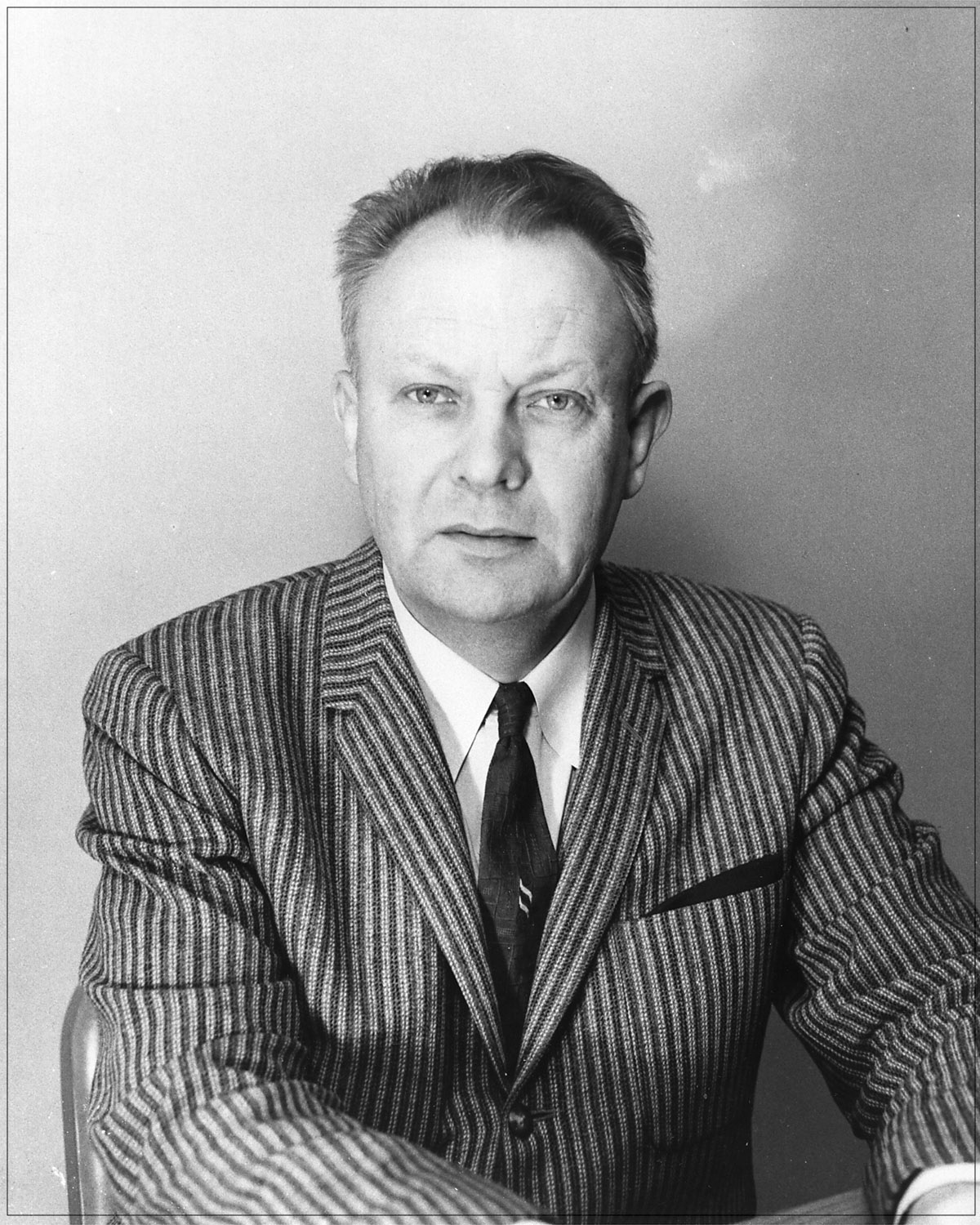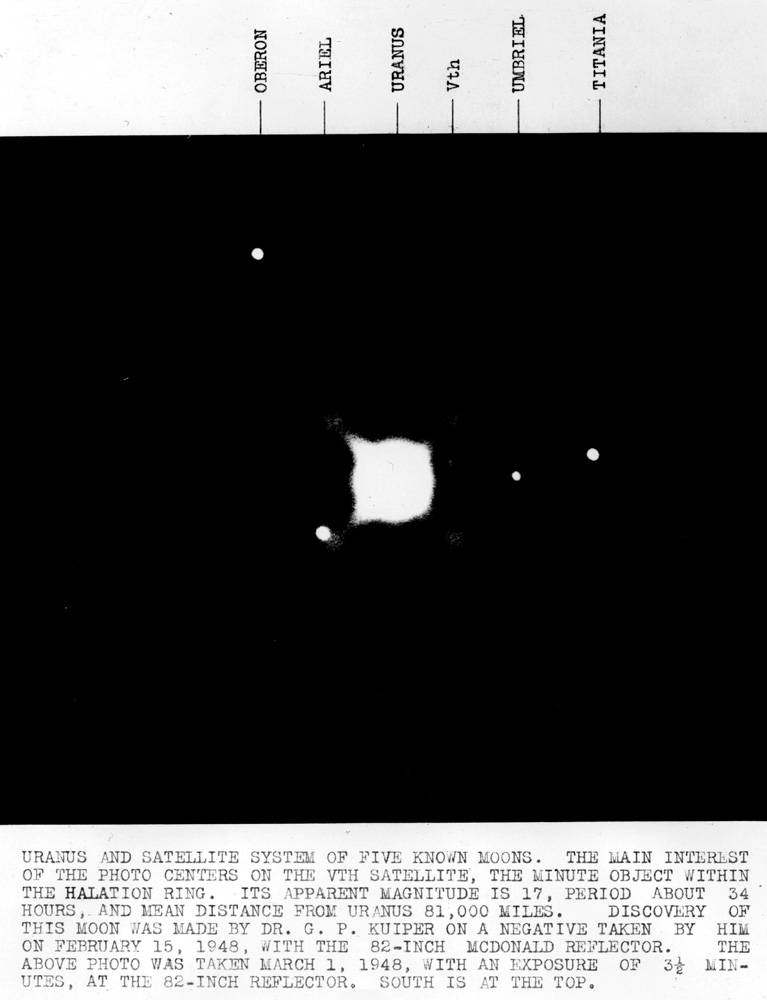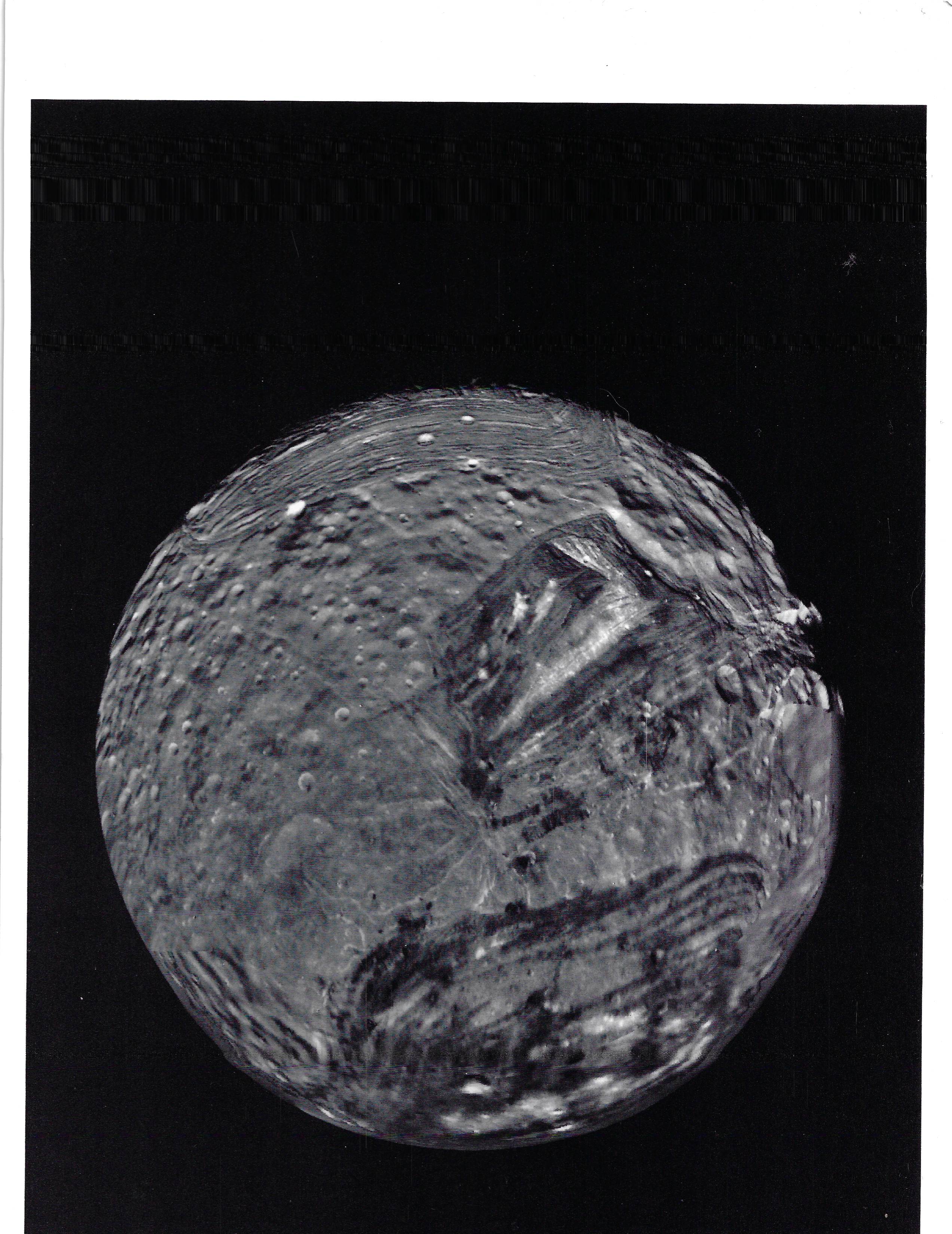This Month in Astronomical History: February 2024
Michael Marotta American Astronomical Society (Amateur Affiliate)
 Each month as part of this series from the AAS Historical Astronomy Division (HAD), an important discovery or memorable event in the history of astronomy will be highlighted. This month, Michael E. Marotta writes about Gerard Kuiper’s discovery of Uranus’s moon, Miranda. Interested in writing a short (500-word) column? Instructions along with previous history columns are available on the HAD web page.
Each month as part of this series from the AAS Historical Astronomy Division (HAD), an important discovery or memorable event in the history of astronomy will be highlighted. This month, Michael E. Marotta writes about Gerard Kuiper’s discovery of Uranus’s moon, Miranda. Interested in writing a short (500-word) column? Instructions along with previous history columns are available on the HAD web page.
Kuiper Discovers Miranda
Five minutes before 3:00 am on 16 February 1948, the 82-inch Cassegrain telescope at the McDonald Observatory captured the first photograph of the moon, Miranda, orbiting Uranus. The instrument was following the program of the observatory director, Gerard P. Kuiper, to establish the magnitudes of the four moons already known at that time. When the plates were developed, the fifth satellite was identified immediately. Verification of the attendant data came from work over the next twelve months, and Kuiper formally announced his discovery in June 1949.1
At that time, the McDonald Observatory was operated jointly by the University of Chicago and the University of Texas, with the University of Chicago (chaired by Subrahmanyan Chandrasekhar) as the senior partner. On 8 March 1949, Chandra wrote to Kuiper outlining the options for teaching in the next academic year and his note called the discovery of Miranda “brilliant.” But Kuiper demurred, saying that, unlike his investigations of Mars and the Rings of Saturn, this find was accidental.2
Rather than false modesty, the denial was consistent with Kuiper’s personality. His commitment to objectivity was primary, even against simple politeness. Although most of the formal biographies give only the facts of his career,3,4 other colleagues have published fond remembrances of his impervious and often bristly exterior.5,6,10 Kuiper did not enjoy teaching and he had little patience for working with students. That was why he was alone at the telescope on the morning Miranda was first photographed. However, he turned the subsequent work of validation over to his doctoral candidate Daniel Lester Harris III.7,9 After Kuiper discovered the moon Nereid orbiting Neptune, Harris worked with George van Biesbroeck to establish the elements of its orbit as part of his doctoral dissertation.8
Through the investigations of Uranus and Neptune, Kuiper was continuing his exhaustive study of the solar system for which he has been called “the father of modern planetary astronomy.”7,10 Dale Cruikshank, Derek Sears, and other historians repeat the claim that planetary astronomy fell into disrepute because of Percival Lowell’s extravagant claims about the canals of Mars. The fact is that the planets are so close and bright that the ever-larger telescopes of the early 20th century revealed no new information. Kuiper changed that in two ways: first, he gave deep thought to the problems; second, he developed infrared sensors that did bring previously unrecorded data.11 Typical of his overarching research plans he edited a four-volume set about the solar system. Volume 2 was The Earth as a Planet. Today, astronomers who study the solar system often begin their academic careers majoring in geology.
After Kuiper discovered Miranda, little more was known about the moon until Voyager 2 reached Uranus on 24 January 1986. Since then, planetary astronomers have been mining the data and fitting the pieces together.
The current theory is that five different events fractured Miranda.12
“Like Frankenstein's monster, Miranda looks like it was pieced together from parts that didn't quite merge properly. At about 500 km in diameter, it's only one-seventh as large as Earth's moon, a size that seems unlikely to support much tectonic activity.
“Yet Miranda sports one of the strangest and most varied landscapes among extraterrestrial bodies, including three large features known as ‘coronae,’ which are unique among known objects in our solar system. They are lightly cratered collections of ridges and valleys, separated from the more heavily cratered (and presumably older) terrain by sharp boundaries like mismatched patches on a moth-eaten coat.”13
It is also true that Miranda’s extremely disparate surface suggests compressional tectonics.14 Covering all of this are two different kinds of regolith — fields of loose, small, and otherwise unrelated particles — the origins of which have not been adequately explained.15

Fig. 1: Gerard P. Kuiper. Image courtesy of McDonald Observatory

Fig. 2: Gerard Kuiper’s first photograph of Miranda. Image apf2-05103.jpg courtesy of University of Chicago Photographic Archive, Hanna Holborn Gray Special Collections Research Center, University of Chicago Library. (This image appeared in Introduction to Astronomy by Cecilia Payne-Gaposchkin, Prentice-Hall, 1954. The McDonald Observatory helped locate the image’s present archive.)

Fig. 3: Uranus’ moon Miranda is shown in a computer-assembled mosaic of images obtained on January 24, 1986, by the Voyager 2 spacecraft. Seven high-resolution images from the Voyager closest approach sequence make up the major portion of this photo. Data from more distant, lower-resolution images were used to fill in gaps along the limb. Image credit: “Miranda P-30232” NASA JPL California Institute of Technology. (Image from document NAS 1.12/7:400-324E scanned by author. Also available at https://www.dvidshub.net/image/709734/south-polar-view-miranda.)

Fig. 4: Miranda’s unusual “chevron” feature and regions of distinctly differing terrain. The bright V-shaped feature in the grooved areas is the 'chevron' observed in earlier, lower-resolution images. Cutting across the bands are sinuous scarps, probably faults. Superimposed on both types of terrain are many bowl-shaped impact craters less than 5 km (3 mi) wide. Image credit: “Miranda P-29515” NASA JPL California Institute of Technology. (Image from document NAS 1.12/78:400-324F scanned by author. Also available at https://photojournal.jpl.nasa.gov/catalog/PIA00038.)
References
- Kuiper, Gerard P. (1949). “The Fifth Satellite of Uranus,” Publications of the Astronomical Society of the Pacific, Vol. 61, No. 360, [June 1949] p.129.
- Sears, Derek W. G. (2019). Gerard P. Kuiper and the Rise of Modern Planetary Science. University of Arizona Press. p. 114.
- Trimble, Virginia. (2014). “Kuiper, Gerard Peter.” In: Hockey, T., et al. Biographical Encyclopedia of Astronomers. Springer, New York, NY. https://doi.org/10.1007/978-1-4419-9917-7_9083
- n.a. (2024). “Arrokoth: About Gerard Kuiper.” The Johns Hopkins University Applied Physics Laboratory. https://pluto.jhuapl.edu/Arrokoth/About-Gerard-Kuiper.php (Accessed 15 January 2024 11:09 CST.)
- Sagan, Carl. (1974). “Obituary: Gerard Peter Kuiper (1905-1973),” Icarus, 22, 117-118.
- n.a. (2022). “Gerard Kuiper (1905-1973),” https://science.nasa.gov/people/gerard-kuiper/#hds-sidebar-nav-4 (Accessed 15 January 2024 09:40 CST.) This article includes reminiscences by Dale Cruikshank, George Coyne, and Alan Binder that came from the Lunar and Planetary Laboratory History of LPL: No Longer Points of Light. https://www.lpl.arizona.edu/about/history/points-of-light
- Sears, Derek W. G. op cit., page 114, and “Kuiper and Students” pages 123-125.
- Kuiper, Gerard P. (1949). “The Second Satellite of Neptune,” Publications of the Astronomical Society of the Pacific, Vol. 61, No. 361, [August 1949] p.175.
- https://astrogen.aas.org/front/searchdetails.php?agnumber=2529
- Cruikshank, Dale P. (1993). “Gerard Peter Kuiper 1905-1973: A Biographical Memoir,” National Academy of Sciences. See also: Cruikshank, Dale P. and Chamberlain, Joseph W. (1999) "The Beginnings of the Division for Planetary Sciences of the American Astronomical Society," in The American Astronomical Society's First Century Volume edited by David H. DeVorkin. 1999. Pages 252-268. https://dps.aas.org/history/chamberlain_cruikshank_1999
- Sears, Derek. (2013). “Gerard Kuiper and the Infrared Detector,” Historical Astronomy Division Meeting, Denver, October 2013, Session #104
- n.a. (2008). Visiting Miranda. https://www.nasa.gov/image-article/visiting-miranda/ (Accessed 14 January 2024 11:28.)
- n.a. (n.d.) “Miranda” https://science.nasa.gov/uranus/moons/miranda/ (Accessed 14 January 2024 11:28.)
- n.a. (1996). Visiting Miranda. https://www.jpl.nasa.gov/images/pia00044-miranda-high-resolution-of-lar…
- Beddingfield, Chloe B., and Cartwright, Richard J. (2022). “Mirandaʼs Thick Regolith Indicates a Major Mantling Event from an Unknown Source,” The Planetary Science Journal, 3:253. (November).

